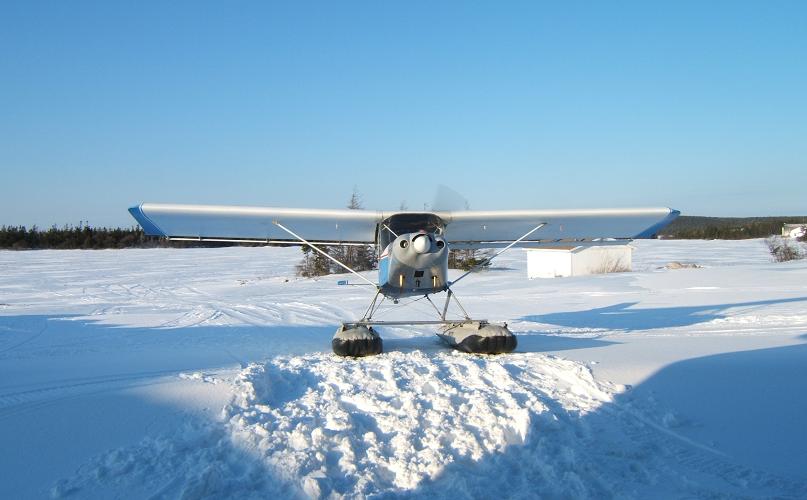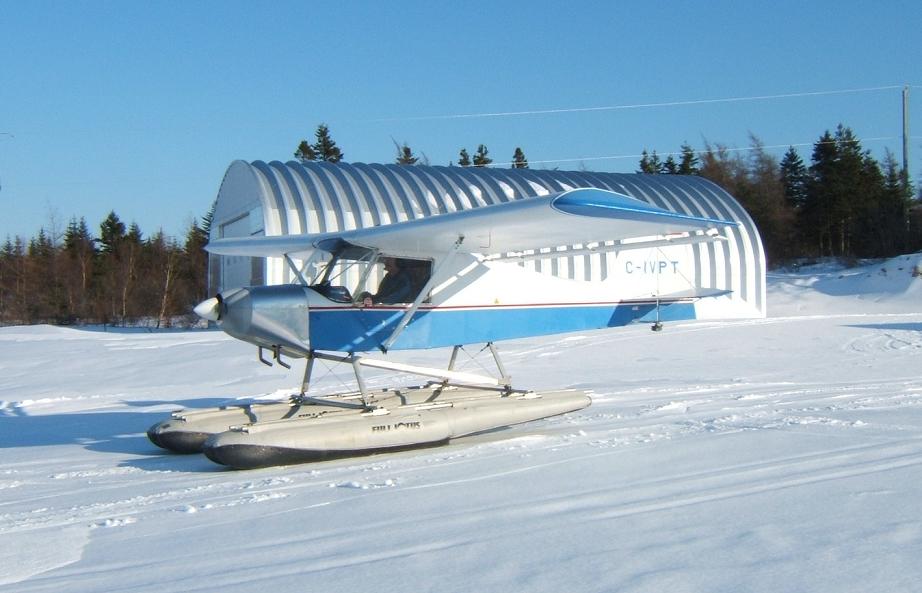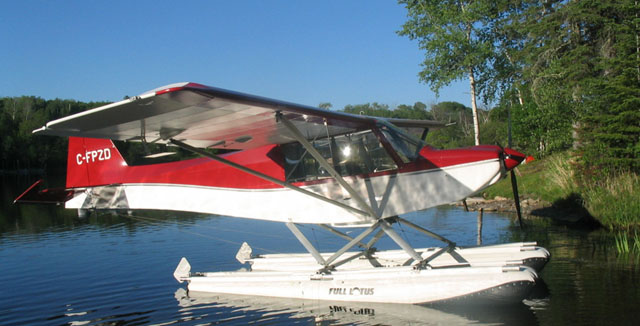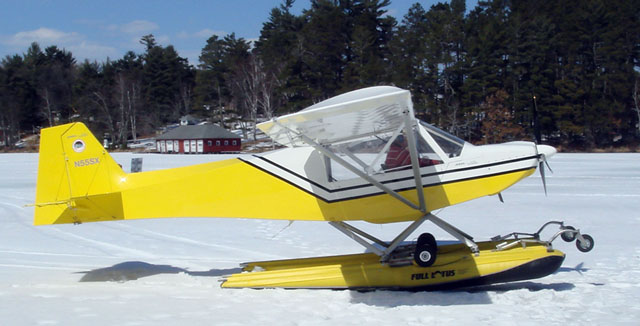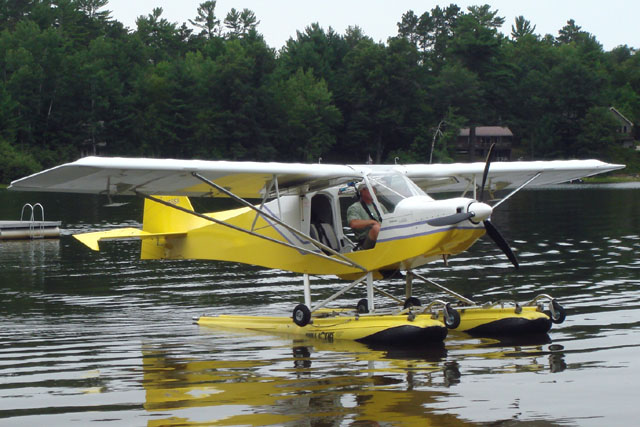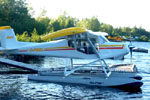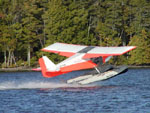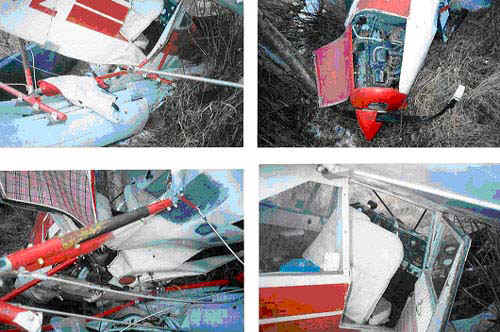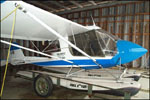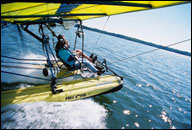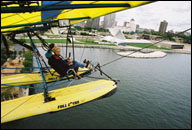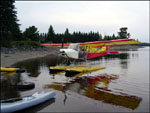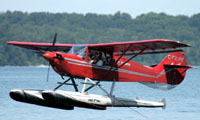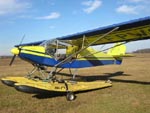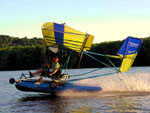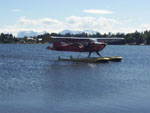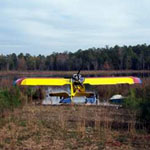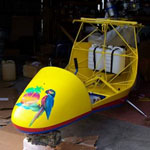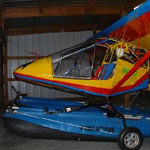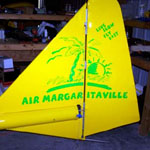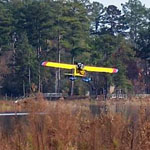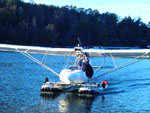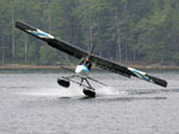ARCHIVE OF FULL-LOTUS INSTALLATIONS:
Full-Lotus owners: If you would like to feature your aircraft here, please contact us; we would be happy to post your information and photos!
Please note: All photos should be sent to us in .jpg format if possible, thank you.
Please note: All photos should be sent to us in .jpg format if possible, thank you.
|
Jeff Moores and his Merlin on FL1450's
Click here to read more on Jeff's year-round flying with his Corvair-powered Merlin on Full-Lotus Floats (includes great videos)! |
|
Brian Sandercock and his Rans S-7 on FL1450's
Here's what Brian had to say: "Just done all my test flights with the new 1450's,very impressed with the setup."....." Very fast on step and off the water and no floatation issues at all."...."Flies very well, quick on step and off the water, and floats beautifully"... |
|
This month our featured pilot is one of our dealers Craig Morse from Manely Sport plans. The aircraft is a Sky Ranger equipped with our FL1260's and a Rotax 912s. The aircraft gets off the water in 6 seconds.
You can find out more about this aircraft and our dealer by contacting them: Tel: 1-207-528-2104 (Home); email: CJM@fairpoint.net |
|
Leonard Parry - Aircraft - Pacer: How Full Lotus Saved My Life
It was Thanksgiving day of 2000, when I decided to go for a spin and take the plane over to a lake close by, in preparation for a duck hunt the following day. I had been keeping the plane in a grass field by the house, but with the load I was going to be taking out tomorrow I wanted more room to lift off. I did a good pre-flight check, while the red-dragon was warming up the engine. After all the covers were off I waved at the kids, fired it up and taxi’d to the far end of the field. A quick mag check and I was on the way. |
Due to the size of the field I was in, as soon as I had 45 MPH indicated, I popped full flaps and jumped the pacer off the ground, held in ground effect just long enough to get a little more speed then pointed the nose to the sky.
At 65 mph and about 50’ altitude I took out the first notch of flaps and pushed the nose over slightly to gain a little more speed. At about 100’ I had cleared the trees; I was reaching for the flap handle when I heard a loud backfire and then the loudest silence I have ever heard in my life. I pushed the nose over and broke the golden rule. #1 rule is to always fly the plane. Well when you break that rule, very seldom do you get a second chance. I very quickly tried to cram about 30 seconds worth of emergency procedures into about 2 seconds of real time. I looked up just in time to see the windshield fill full of dirt, snow and grass.
Anyone who has flown a Pacer knows that when the pilot’s cooling fan quits turning, you are landing RIGHT NOW. On floats the situation is even worse. At this point I blacked out, but I do remember very clearly that my last thought was “oh S%^t this is gonna hurt”….I woke up with in seconds of coming to a rest and immediately turned off the gas tanks, and killed the master. As I crawled out of the wreckage, I could hear my two boys running across the field screaming. I yelled at them to let them know I was OK. Within minutes paramedics were on the scene, but that turns into another story all together.
The owner of the field had come up by this time and was talking to me about what happened. He had witnessed the whole thing and told me that the right wing tip and float hit the ground at the same time at about a 75 degree nose down attitude “hauling @ss”. The nose of the floats folded up then sprang back throwing me back into the air where I came to a rest 63.5’ later in the tree line. In surveying the wreckage and looking at the area of impact, it did not take a rocket scientist to figure out that the Full-Lotus floats had just saved my life. There is not even the slightest doubt in my mind that had I not had 16 airbags under my butt at the point of impact, I would have been planted in that field, and my family would not been able to salvage that Thanksgiving day dinner. In looking back at that day, it is hard to think of what the boys would have witnessed had I not been on those floats.
I now have an Avid Flyer that is going on a set Full-Lotus floats as I will not put anything else on a plane I own unless there is not a size available for what I would need.
~ Leonard Perry – Soldotna, Alaska
At 65 mph and about 50’ altitude I took out the first notch of flaps and pushed the nose over slightly to gain a little more speed. At about 100’ I had cleared the trees; I was reaching for the flap handle when I heard a loud backfire and then the loudest silence I have ever heard in my life. I pushed the nose over and broke the golden rule. #1 rule is to always fly the plane. Well when you break that rule, very seldom do you get a second chance. I very quickly tried to cram about 30 seconds worth of emergency procedures into about 2 seconds of real time. I looked up just in time to see the windshield fill full of dirt, snow and grass.
Anyone who has flown a Pacer knows that when the pilot’s cooling fan quits turning, you are landing RIGHT NOW. On floats the situation is even worse. At this point I blacked out, but I do remember very clearly that my last thought was “oh S%^t this is gonna hurt”….I woke up with in seconds of coming to a rest and immediately turned off the gas tanks, and killed the master. As I crawled out of the wreckage, I could hear my two boys running across the field screaming. I yelled at them to let them know I was OK. Within minutes paramedics were on the scene, but that turns into another story all together.
The owner of the field had come up by this time and was talking to me about what happened. He had witnessed the whole thing and told me that the right wing tip and float hit the ground at the same time at about a 75 degree nose down attitude “hauling @ss”. The nose of the floats folded up then sprang back throwing me back into the air where I came to a rest 63.5’ later in the tree line. In surveying the wreckage and looking at the area of impact, it did not take a rocket scientist to figure out that the Full-Lotus floats had just saved my life. There is not even the slightest doubt in my mind that had I not had 16 airbags under my butt at the point of impact, I would have been planted in that field, and my family would not been able to salvage that Thanksgiving day dinner. In looking back at that day, it is hard to think of what the boys would have witnessed had I not been on those floats.
I now have an Avid Flyer that is going on a set Full-Lotus floats as I will not put anything else on a plane I own unless there is not a size available for what I would need.
~ Leonard Perry – Soldotna, Alaska
My father and I just purchased this Challenger on Full Lotus Floats and decided to test her on the water. After a few low and high speed taxis, I felt confident enough to take off. I spent an hour in the air and completed 6 landings. With these floats I was surprised at how much it was like to landing on wheels. We have a small trailer and its very easy to put on the trailer, not having to worry about bumping them.
We live in Labrador and look forward to many trips to the various lakes. We may even leave them on all winter as I hear they are ideal for winter as well. We have decided to add the water rudder kit to make it a bit easier to handle as we are operating on a river. As I said before, I have never had any time on floats, but the Full Lotus Floats make it seem very easy.
Thank-you.
~ Rich & Harry Martin
We live in Labrador and look forward to many trips to the various lakes. We may even leave them on all winter as I hear they are ideal for winter as well. We have decided to add the water rudder kit to make it a bit easier to handle as we are operating on a river. As I said before, I have never had any time on floats, but the Full Lotus Floats make it seem very easy.
Thank-you.
~ Rich & Harry Martin
Several years ago I decided to get back into ultralight instructing. Leaving on a lake outside of Milwaukee, it was only natural that I decided to put it on floats. After researching the various floats available, I chose Full Lotus.
I’ve owned single and twin-engine aircraft but the Quicksilver on Lotus floats is the most fun I’ve ever had flying. Skimming across a lake a couple inches above the water is just an incredible feeling. What surprised me most, however, is how much more variety of flying I did on floats than wheels. In our area of the country it’s amazing how much water there is available. I’ve landed in pools of water in cornfields after heavy rains. I’ve flown down to Lake Michigan and then taxied up the river into downtown Milwaukee. The sight of an ultralight on floats in the middle of a major metropolitan area sure gets some interesting looks.
I also enjoy going out to a grass airport after a rainstorm and taking off and landing on the wet grass. It feels like a magic carpet. The floats are loads of fun on snow, too.
Having used fiberglass floats, the best thing about Lotus floats is how tough they are. All non-inflatable floats leak. Lotus floats don’t’ and will also take a ton more punishment. Because the floats don’t leak, I leave my ultralight sitting on the water 90% of the time. However, when storms threaten, I run it up a plywood ramp onto shore to tied it down. It would be impossible to let it sit on the water or run it up the plywood ramp without Lotus floats.
I have a number of airline pilot friends including one that flies 747s internationally. Every one describes flying the Quicksilver on Lotus floats as some of the most fun they’ve ever had with aviation. If you’ve never flown floats before, it’s a whole new realm of flying.
I’ve owned single and twin-engine aircraft but the Quicksilver on Lotus floats is the most fun I’ve ever had flying. Skimming across a lake a couple inches above the water is just an incredible feeling. What surprised me most, however, is how much more variety of flying I did on floats than wheels. In our area of the country it’s amazing how much water there is available. I’ve landed in pools of water in cornfields after heavy rains. I’ve flown down to Lake Michigan and then taxied up the river into downtown Milwaukee. The sight of an ultralight on floats in the middle of a major metropolitan area sure gets some interesting looks.
I also enjoy going out to a grass airport after a rainstorm and taking off and landing on the wet grass. It feels like a magic carpet. The floats are loads of fun on snow, too.
Having used fiberglass floats, the best thing about Lotus floats is how tough they are. All non-inflatable floats leak. Lotus floats don’t’ and will also take a ton more punishment. Because the floats don’t leak, I leave my ultralight sitting on the water 90% of the time. However, when storms threaten, I run it up a plywood ramp onto shore to tied it down. It would be impossible to let it sit on the water or run it up the plywood ramp without Lotus floats.
I have a number of airline pilot friends including one that flies 747s internationally. Every one describes flying the Quicksilver on Lotus floats as some of the most fun they’ve ever had with aviation. If you’ve never flown floats before, it’s a whole new realm of flying.
Prop is a 2 blade 72” Warp on a Rotax 912 80hp. Many people install the 100hp Rotax but the 80 has several advantages. It is a smoother running engine due to the lower compression ratio which also allows you to burn regular auto gas (or marine gas when on floats). The 100 needs premium. If you are used to heavier aircraft like Cubs and Champs you will be amazed at the performance with 80hp. You don’t need more even on a hot day at gross on floats. On wheels of course performance is spectacular.
Full Lotus floats are terrific. They can take a lot of abuse from rocks or shallow water and handle really well. I've just finished re-working most of the float rigging on this one. This is a two man plus baggage float plane with excellent performance.
With two 200 pounders I can get off quicker than a 150hp Super Cub.I think you would be amazed at how small a lake you can operate in.
Full Lotus floats are terrific. They can take a lot of abuse from rocks or shallow water and handle really well. I've just finished re-working most of the float rigging on this one. This is a two man plus baggage float plane with excellent performance.
With two 200 pounders I can get off quicker than a 150hp Super Cub.I think you would be amazed at how small a lake you can operate in.
I selected the Magnum kit with float flying in mind and early in '03 got serious about it. I learned of two other Magnums on floats - one on 1500 aluminum and one on 2150 F-L. Both builder/owner/pilots let me fly their a/c and gave me good info on their experience installing floats, tuning rigging and flying. I also spoke to two Rebel "drivers" who flew on F-L floats and got good reports.
The two Magnums I flew had similar T-O times, but I soon learned that each type of float has its pros and cons. Metal floats have keels and sharp chines and can carve turns on the water at speeds above displacement mode; F-L floats tend to skid sideways over the water during a turn at speeds above plowing. Also, in a brisk wind, it takes a boot full of rudder to turn from downwind taxi to up-wind for take-off. Given adequate "sea room", none of this is a problem.
Four things finally sold me on F-L. The take off time was comparable to metal floats; they resist abrasion on rocky shorelines that could easily and expensively damage metal floats; they soften choppy water take-offs and don't shake my instruments out of the panel, and they soften landings in both choppy and smooth water. (I didn't have a lot of float experience and some of my landings benefited from the forgiving nature of the air bags!)
I designed and built my struts and rigging from scratch using salvage yard parts. Other pilots' advice helped with the design, and the F-L manual gave good info on rigging and on the all-important placement of the step with respect to CofG. I built the aft struts to allow change in the initial (3 degree) wing/float angle, but never had to use it. Right from the start, water handling and take-off performance were good. I did have to make a couple of other changes. My vertical tail is small, so I had to install a ventral fin to improve stability in turns aloft and because the float bows create big drag during final approach at low power setting, I lowered the horizontal stabilizer leading edge to alleviate the initial need for excessive back-stick.
Current specs are ... empty/gross weights are 1165/1750 lbs. Floats added 200# net after removing wheels. Don't know if they contribute some lift and therefore justify an increase in allowable GW. It hasn't been worth pursuing. With prop pitch at 11 degrees, the a/c gets on the step quickly and in calm conditions, it breaks free in about 11-13 seconds from power on, depending on load. Cruise speed is down from 125 mph on wheels to 105 on floats, but the type of flying I do is now mostly low and slow at about 2150 rpm and 90-95 mph.
After three summers of float flying, I'm super pleased with my Magnum/F-L combination! I'd be happy to help anyone who thinks I might have experience or information worth sharing and will show my a/c to anyone who is interested. Contact me at wjhone@sympatico.ca.
The two Magnums I flew had similar T-O times, but I soon learned that each type of float has its pros and cons. Metal floats have keels and sharp chines and can carve turns on the water at speeds above displacement mode; F-L floats tend to skid sideways over the water during a turn at speeds above plowing. Also, in a brisk wind, it takes a boot full of rudder to turn from downwind taxi to up-wind for take-off. Given adequate "sea room", none of this is a problem.
Four things finally sold me on F-L. The take off time was comparable to metal floats; they resist abrasion on rocky shorelines that could easily and expensively damage metal floats; they soften choppy water take-offs and don't shake my instruments out of the panel, and they soften landings in both choppy and smooth water. (I didn't have a lot of float experience and some of my landings benefited from the forgiving nature of the air bags!)
I designed and built my struts and rigging from scratch using salvage yard parts. Other pilots' advice helped with the design, and the F-L manual gave good info on rigging and on the all-important placement of the step with respect to CofG. I built the aft struts to allow change in the initial (3 degree) wing/float angle, but never had to use it. Right from the start, water handling and take-off performance were good. I did have to make a couple of other changes. My vertical tail is small, so I had to install a ventral fin to improve stability in turns aloft and because the float bows create big drag during final approach at low power setting, I lowered the horizontal stabilizer leading edge to alleviate the initial need for excessive back-stick.
Current specs are ... empty/gross weights are 1165/1750 lbs. Floats added 200# net after removing wheels. Don't know if they contribute some lift and therefore justify an increase in allowable GW. It hasn't been worth pursuing. With prop pitch at 11 degrees, the a/c gets on the step quickly and in calm conditions, it breaks free in about 11-13 seconds from power on, depending on load. Cruise speed is down from 125 mph on wheels to 105 on floats, but the type of flying I do is now mostly low and slow at about 2150 rpm and 90-95 mph.
After three summers of float flying, I'm super pleased with my Magnum/F-L combination! I'd be happy to help anyone who thinks I might have experience or information worth sharing and will show my a/c to anyone who is interested. Contact me at wjhone@sympatico.ca.
|
Jim Hill and Quicksilver Sprint II on Full Lotus Floats
USUA Club 99 had one of it's favorite fly/ins in Cassville, Wisconsin on Father's Day weekend, June 17, 18, 19th., 2005. The Al Muller family opens up their Mississippi River cabin home for all of us to enjoy, with food, sleeping accommodations, and fun for all. |
The weather was absolutely perfect, and we all took advantage of it ! Attendance was the best ever with 18 ultralights, and more general aviation arriving for the concurrent Sunday am Cassville fly/in breakfast.
But this year was really special…. with the arrival of our first "Float plane" in our club. You think flying on land is fun - what an INCREDIBLE experience FLOAT FLYING IS!!!
I, the pilot, was flying a new Quicksilver Sprint II with 12 ft. Full Lotus Floats, and complete retractable landing gear.
With Rick Seeley, my cameraman ready to start filming, we took off for the river with our camera boat crew and the new Float plane. Rick filmed about 2 hours of incredible video from the boat, including numerous landings, takeoffs, and the beautiful Mississippi river scenery. With all the excitement of the videotaping, Rick almost fell out of the boat, but he and the camera were "Saved " at the last minute by the observers in the boat. After we returned to the dock, our enthusiastic cameraman was so excited, he could hardly wait to return home to edit and prepare our final movie DVD.
Rick did not have the opportunity to film the earlier flight, where I and a passenger landed in the river, WITHOUT retracting the landing wheels……did not flip over, but so close, I'll never forget to retract the wheels again !
To all ultralight pilots, you can't imagine what a rush it is--- to land right down the main channel of the incredibly beautiful Mississippi River. What a great weekend!!!
Jim is also one of our dealers, you can contact him using the information below:
Ultralight Aircraft of Iowa Tel: 1-800-852-8756; Website: http://www.quicksilverultralight.com
But this year was really special…. with the arrival of our first "Float plane" in our club. You think flying on land is fun - what an INCREDIBLE experience FLOAT FLYING IS!!!
I, the pilot, was flying a new Quicksilver Sprint II with 12 ft. Full Lotus Floats, and complete retractable landing gear.
With Rick Seeley, my cameraman ready to start filming, we took off for the river with our camera boat crew and the new Float plane. Rick filmed about 2 hours of incredible video from the boat, including numerous landings, takeoffs, and the beautiful Mississippi river scenery. With all the excitement of the videotaping, Rick almost fell out of the boat, but he and the camera were "Saved " at the last minute by the observers in the boat. After we returned to the dock, our enthusiastic cameraman was so excited, he could hardly wait to return home to edit and prepare our final movie DVD.
Rick did not have the opportunity to film the earlier flight, where I and a passenger landed in the river, WITHOUT retracting the landing wheels……did not flip over, but so close, I'll never forget to retract the wheels again !
To all ultralight pilots, you can't imagine what a rush it is--- to land right down the main channel of the incredibly beautiful Mississippi River. What a great weekend!!!
Jim is also one of our dealers, you can contact him using the information below:
Ultralight Aircraft of Iowa Tel: 1-800-852-8756; Website: http://www.quicksilverultralight.com
|
Russell Holmes
Hello fellow float flying enthusiasts!!! I’m Russell Holmes and the pictures are of my Kitfox III on Lotus 1260 tail dragger amphibious floats. I’ve been flying since 1986 and for 10 of those years I rented Cessna’s but my dream was always to have my own cottage and airplane and it made a lot of financial sense to have one that I could keep at my cottage to save on costly hanger rental and airport fees. |
Also with a floatplane you don’t have to mow the grass on the runway every week or worry about ruts or other maintenance issues or pay taxes on the acreage of land. The cottage is centrally located on Mississippi Lake in Ontario, and I have 4.5 miles of emergency runway ahead in either direction in case I need it. The cottage is also in the flood plain and almost every spring the lake water rises and floods the spot where the hanger is so it also made a lot of sense to have floats that I could leave on and use as skis in the winter but also be ready in the spring if the hanger flooded. Lotus floats were the only floats with this capability plus they were the only ones recommended to me by Skystar for the Kitfox.
As far as the plane goes I wanted an aircraft that I could maintain myself with folding wings so I could keep it in a narrow hanger made necessary because of the narrow lot. In 1997 I found this nicely built Kitfox III for sale with a Rotax 582, float attachment fittings and seaplane fabric drains that only had 3 hours on it. In hindsight a Kitfox IV with an additional 150 lbs of gross weight capability and an 80hp or more engine would have been a better choice as the climb rate is currently a concern and the 1050 lb gross weight limitations will only allow me to take gas or a passenger but not both at the same time.
Another issue I had to consider was that the hanger couldn’t be at the water’s edge because the neighbour’s cottage overlooked that part of my property so it would have blocked their view. Therefore the hanger was located back about 60 feet from the water and at the side of the property to avoid blocking my view. Unfortunately this also means that the plane has to make a turn en-route to the hanger. The long distance over grass and the turn made a marine railway undesirable but this could be overcome by using the amphibious main landing gear. The tail wheels are too small to give support through sand and the rudder springs allowed them to wander when backing up so I overcame this challenge by building a large dolly with very large casters that I rest the back end of the floats on. I pull the airplane out of the lake, up the slope, with a 12Volt electric winch mounted on a pressure washer cart that is anchored in the hanger. The winch controller cord was too short to stand by the plane and guide it however this was overcome by cutting the wire and attaching the ends to regular 120V male and female electrical cord ends. With a regular 75 foot extension cord plugged in the middle I’m able to stand by the plane and guide it and operate the winch at the same time. The water is shallow and sandy and the main wheels sink a bit at the waters edge but this has been improved by laying down two 4’ x 8’ sheets of flat plastic fence screening. Where there’s a will there’s a way!
I bought the floats used circa 2000 with struts and a water rudder from a gentleman who had them on a Kitfox IV. I stopped renting airport hanger space in 2001 and moved the plane to the newly erected cottage hanger. The plumbing needed repairs and my family took exception to using a porta-poti so the priorities changed through 2003 until once again all toilet systems were on the go.
The previous owner had used a higher angle of attack than what Skystar had recommended so I moved the struts to conform to the Skystar instructions. I bought and installed a dorsal fin and a special reinforcement brace that the model III needed for floats.
I earned my float endorsement in 1994 but hadn’t flown off water since then so to prepare myself for the first flight on the floats I watched the EAA video on Flying on Floats several times as well as the Lotus video.
Finally in September 2004 the plane was ready for testing and a calm day appeared. Not having flown at all for 3 years and not having flown on floats for 10 brought a bit of apprehension when I throttled up for my first water take-off however the plane broke free at 45 MPH and climbed steadily without any problems. After a few seconds I reduced power and made a smooth uneventful landing. The rest of my flight goes down as my favourite flight ever as I used up the rest of the gas doing touch and goes…up and down the lake in both directions, while passing boaters waved back.
The floats have worked out fine with lots of displacement to keep the plane high in the water, especially the front. The lighter planes in the Lotus video popped off the water in no time however the heavier Kitfox does require traditional float flying techniques for takeoff.
Recently I tried the floats on a very windy day and had to do a plow turn downwind to make room for takeoff. I used the techniques taught in the EAA Video and had absolutely no problems making that turn downwind with the Lotus floats. The inflatable floats noticeably reduced the pounding that otherwise would have been experienced in my aluminium boat with those waves.
I accidentally damaged the landing gear late last fall when pulling the airplane out of the lake as the previous owner had failed to make sure that both sides of the landing gear would lock in the down position and I hadn’t until that time been able to figure out what to do about it. The result was one wheel rotated up when the weight transferred from the floats to the wheels, damaging the bolt holes in the tube connecting the gear arms and the aluminium bar/arm that rotates the tube. To solve the problem I enlarged the holes in the collar and arm by filling strategically on one side of the holes only. Once done and a larger diameter bolt installed, the collar had rotated enough to make it lock at the same time as the other side. I also introduced some slack and a screen door spring into the retract winch cables to allow for minor rotation of the tube between stops.
Another perplexing problem involved the retract cables that stop the gear from rotating back. When taxiing in the water and raising the wheels the cables would loop around the wheels. The cables in this position would prevent the wheels from going back down. To overcome this I used a short piece of bungee cord to tie the cable to the edge of the bottom skins. When the wheels are down the cable touches the edge of the bottom skins so I used this location to drill a hole for a tie wrap that I put the bungee cord through and tied it to the retract cable. An easy, lightweight solution to a puzzling problem. All these landing gear modifications from what the original owner had are working out well.
Thanks to Lotus for making available safe, quality, amphibious, all season floats to the homebuilding market and allowing me share my story about putting together my airplane and storage systems.
Because of Lotus and the folding wings of the Kitfox I’ve been able to realize a lifelong dream to have an affordable amphibious airplane with all season capability and to keep it in a hanger at my favourite place on Earth…..the cottage that I grew up going too, complete with hanger, flooding and shoreline challenges. With all the hundred of dollars I’m saving by keeping it there maybe I’ll be able to afford a couple more litres of gas to go flying!!!!
As far as the plane goes I wanted an aircraft that I could maintain myself with folding wings so I could keep it in a narrow hanger made necessary because of the narrow lot. In 1997 I found this nicely built Kitfox III for sale with a Rotax 582, float attachment fittings and seaplane fabric drains that only had 3 hours on it. In hindsight a Kitfox IV with an additional 150 lbs of gross weight capability and an 80hp or more engine would have been a better choice as the climb rate is currently a concern and the 1050 lb gross weight limitations will only allow me to take gas or a passenger but not both at the same time.
Another issue I had to consider was that the hanger couldn’t be at the water’s edge because the neighbour’s cottage overlooked that part of my property so it would have blocked their view. Therefore the hanger was located back about 60 feet from the water and at the side of the property to avoid blocking my view. Unfortunately this also means that the plane has to make a turn en-route to the hanger. The long distance over grass and the turn made a marine railway undesirable but this could be overcome by using the amphibious main landing gear. The tail wheels are too small to give support through sand and the rudder springs allowed them to wander when backing up so I overcame this challenge by building a large dolly with very large casters that I rest the back end of the floats on. I pull the airplane out of the lake, up the slope, with a 12Volt electric winch mounted on a pressure washer cart that is anchored in the hanger. The winch controller cord was too short to stand by the plane and guide it however this was overcome by cutting the wire and attaching the ends to regular 120V male and female electrical cord ends. With a regular 75 foot extension cord plugged in the middle I’m able to stand by the plane and guide it and operate the winch at the same time. The water is shallow and sandy and the main wheels sink a bit at the waters edge but this has been improved by laying down two 4’ x 8’ sheets of flat plastic fence screening. Where there’s a will there’s a way!
I bought the floats used circa 2000 with struts and a water rudder from a gentleman who had them on a Kitfox IV. I stopped renting airport hanger space in 2001 and moved the plane to the newly erected cottage hanger. The plumbing needed repairs and my family took exception to using a porta-poti so the priorities changed through 2003 until once again all toilet systems were on the go.
The previous owner had used a higher angle of attack than what Skystar had recommended so I moved the struts to conform to the Skystar instructions. I bought and installed a dorsal fin and a special reinforcement brace that the model III needed for floats.
I earned my float endorsement in 1994 but hadn’t flown off water since then so to prepare myself for the first flight on the floats I watched the EAA video on Flying on Floats several times as well as the Lotus video.
Finally in September 2004 the plane was ready for testing and a calm day appeared. Not having flown at all for 3 years and not having flown on floats for 10 brought a bit of apprehension when I throttled up for my first water take-off however the plane broke free at 45 MPH and climbed steadily without any problems. After a few seconds I reduced power and made a smooth uneventful landing. The rest of my flight goes down as my favourite flight ever as I used up the rest of the gas doing touch and goes…up and down the lake in both directions, while passing boaters waved back.
The floats have worked out fine with lots of displacement to keep the plane high in the water, especially the front. The lighter planes in the Lotus video popped off the water in no time however the heavier Kitfox does require traditional float flying techniques for takeoff.
Recently I tried the floats on a very windy day and had to do a plow turn downwind to make room for takeoff. I used the techniques taught in the EAA Video and had absolutely no problems making that turn downwind with the Lotus floats. The inflatable floats noticeably reduced the pounding that otherwise would have been experienced in my aluminium boat with those waves.
I accidentally damaged the landing gear late last fall when pulling the airplane out of the lake as the previous owner had failed to make sure that both sides of the landing gear would lock in the down position and I hadn’t until that time been able to figure out what to do about it. The result was one wheel rotated up when the weight transferred from the floats to the wheels, damaging the bolt holes in the tube connecting the gear arms and the aluminium bar/arm that rotates the tube. To solve the problem I enlarged the holes in the collar and arm by filling strategically on one side of the holes only. Once done and a larger diameter bolt installed, the collar had rotated enough to make it lock at the same time as the other side. I also introduced some slack and a screen door spring into the retract winch cables to allow for minor rotation of the tube between stops.
Another perplexing problem involved the retract cables that stop the gear from rotating back. When taxiing in the water and raising the wheels the cables would loop around the wheels. The cables in this position would prevent the wheels from going back down. To overcome this I used a short piece of bungee cord to tie the cable to the edge of the bottom skins. When the wheels are down the cable touches the edge of the bottom skins so I used this location to drill a hole for a tie wrap that I put the bungee cord through and tied it to the retract cable. An easy, lightweight solution to a puzzling problem. All these landing gear modifications from what the original owner had are working out well.
Thanks to Lotus for making available safe, quality, amphibious, all season floats to the homebuilding market and allowing me share my story about putting together my airplane and storage systems.
Because of Lotus and the folding wings of the Kitfox I’ve been able to realize a lifelong dream to have an affordable amphibious airplane with all season capability and to keep it in a hanger at my favourite place on Earth…..the cottage that I grew up going too, complete with hanger, flooding and shoreline challenges. With all the hundred of dollars I’m saving by keeping it there maybe I’ll be able to afford a couple more litres of gas to go flying!!!!
|
Tom Young - Homer, Alaska
This is N850AF an Arctic Fox, one of a kind. 39 foot wing span, 1200 lb empty weight, (on wheels), lycoming 0-360 205 hp w/ a 84x45 prop. Cruise on wheels is 105, on floats is 100. Four seats. VFR only Wings are ribblet airfoil w/ 37.6 US gal per side. Take off and landing performance is exceptional. |
Designed, built and owned by Tom Young, Homer Alaska
Tom Young is the only known pilot in the world using Full Lotus 2600's our largest floats available. Tom purchased the FL2600's back in 1997 and after moving from Colorado to Alaska has installed his floats just recently in 2005. After several conversations with Tom he has told us that is really enjoying the floats and that they are working great for him. We are excited to see such a large aircraft on Full Lotus floats, Tom jokes about using to RV-6's under each wing as tie downs at the air shows, and we believe it. We look forward to hearing more from Tom.
Tom Young is the only known pilot in the world using Full Lotus 2600's our largest floats available. Tom purchased the FL2600's back in 1997 and after moving from Colorado to Alaska has installed his floats just recently in 2005. After several conversations with Tom he has told us that is really enjoying the floats and that they are working great for him. We are excited to see such a large aircraft on Full Lotus floats, Tom jokes about using to RV-6's under each wing as tie downs at the air shows, and we believe it. We look forward to hearing more from Tom.
Robert Broadwell
The aircraft (Kolb Mark III Classic) jumps off the water in about 6 seconds or less. I fly out of Lake Murray, SC and live at the lake, so it is really nice having a float plane. This plane was completely rebuilt recently and sports a 100HP Rotax 912S. Two of my retired friends helped me with the project and picked an "Air Margaretaville" paint theme along with custom airbrushed graphics on the nose, tail, and seats. With it's flashy Aerothane paint job and fancy graphics, it's a real show stopper on the lake during the summer months.
This aircraft was originally equipped with a 65hp Rotax 582 and would lift two adults off the water. It was somewhat underpowered with that motor, but I flew it during the hot S.C. summer months without much trouble getting airborne. I am a seaplane rated BFI and will likely do some limited training. After I get about 40 hours flown off of this newly rebuilt configuration.
I chose Full-Lotus floats due to their everyday "bullet-proof" utility. They also permit operation of the aircraft in a way that Fiberglass or aluminum floats simply cannot do. I can drive onto beaches that would shred any other float. I can run into my dock without damaging anything but my pride. An underwater stump is a non-event, and off field landings or landings with the gear up are possible with little to no damage. The other huge benefit is that these floats absorb punishment before it is transmitted into the airframe. Having 16 airbags (the float bladders), provides for considerable
flotation redundancy. I can take off on far rougher water than I would ever attempt with a rigid float system. Had I installed rigid floats, I am certain that I would have destroyed at least one pair when my landing gear failed to lock properly. I landed quite uneventfully on the floats at my grass strip with no damage whatsoever. Rigid floats would have been ruined or badly damaged at best.
This aircraft was originally equipped with a 65hp Rotax 582 and would lift two adults off the water. It was somewhat underpowered with that motor, but I flew it during the hot S.C. summer months without much trouble getting airborne. I am a seaplane rated BFI and will likely do some limited training. After I get about 40 hours flown off of this newly rebuilt configuration.
I chose Full-Lotus floats due to their everyday "bullet-proof" utility. They also permit operation of the aircraft in a way that Fiberglass or aluminum floats simply cannot do. I can drive onto beaches that would shred any other float. I can run into my dock without damaging anything but my pride. An underwater stump is a non-event, and off field landings or landings with the gear up are possible with little to no damage. The other huge benefit is that these floats absorb punishment before it is transmitted into the airframe. Having 16 airbags (the float bladders), provides for considerable
flotation redundancy. I can take off on far rougher water than I would ever attempt with a rigid float system. Had I installed rigid floats, I am certain that I would have destroyed at least one pair when my landing gear failed to lock properly. I landed quite uneventfully on the floats at my grass strip with no damage whatsoever. Rigid floats would have been ruined or badly damaged at best.
It has a 2SI, 70HP 2 cycle , water cooled, engine, with a max RPM of 6200. Dan use's a 3 blade Warp Drive propeller. The empty weight of the Freebird with amphibious floats is 690 pounds. It carries 10 gal. of premixed fuel. It took Dan about 2 months of part time work , to design a mounting system and make all adjustments by trial and error. "If I lived on the water and was retired, I could probably have accomplished this in a week", states Dan.
Dan has used the Aircraft Sales and Parts main gear from there retract system and has put used the castoring tailwheels, along with a single rudder kit from Full Lotus Mfg.
Dan has used the Aircraft Sales and Parts main gear from there retract system and has put used the castoring tailwheels, along with a single rudder kit from Full Lotus Mfg.
|
Robert Hurd
MAXIMUM UTILITY!!!! In 1992, I installed lotus floats on my drifter; not the aluminum floats that I had bought; not the fiberglass floats that I thought were so great; but the tough inflatable lotus float that makes float flying fun. Flying with out the worry about rocks, docks and other hard things that would ruin my day if I didn't have tough floats. |
I also installed the lotus retractable gear system that I modify, getting rid of 95% of the weight and 95% of the complexity. To give you an idea of how much I have maxed my maximum utility; when flying to the Mohawk Valley fly in I have been known to have on the aircraft, one 21 speed mountain bike mounted on top of one of the floats in the upright position. In the wings, I have access holes made with zippers sewn in the shape of the letter "C", and these are large holes big enough to allow me to carry two aluminum chairs, two sleeping bags, one large aluminum cot, one four man tent, one camp stove, several extra bottles of oil, clothing to last me two weeks, two beach towels, a couple of kites for playtime, two extra pairs of shoes, charts, maps, photo album, cold weather gear, tool kit with extra spark plugs, a cpap machine for breathing at night and a battery to power it, and of course log books for my students and most important all the required paperwork that proves that I am legal. Now once I arrive at the event I strip every thing out of the aircraft except the paperwork. I also keep on board several tie downs tarps and first aid kit.
Am I having fun? You bet I am and I want to thank all the people in the organizations that support this hobby. THANK YOU!!!
Am I having fun? You bet I am and I want to thank all the people in the organizations that support this hobby. THANK YOU!!!

